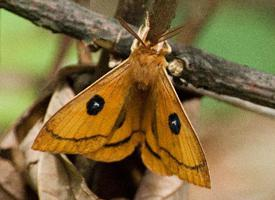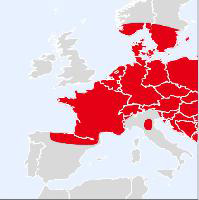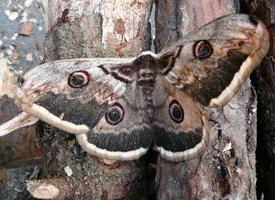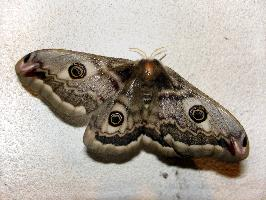
Popis zvířete
The Tau Emperor (Aglia tau) is a fascinating species of moth belonging to the Saturniidae family, which is known for its remarkable size and stunning wing patterns. This moth is widely distributed across the temperate regions of Europe and Asia, with its presence spanning from France in the west to Japan in the east, and from Scandinavia in the north down to the Mediterranean and Iran in the south.The adult Tau Emperor boasts an impressive wingspan that ranges between 60 to 75 millimeters for males and 70 to 100 millimeters for females, making it one of the larger moth species within its geographical range. The males and females exhibit sexual dimorphism, not just in size but also in their wing coloration and patterns. Males typically have a rich brown to reddish-brown hue with a distinctive tau-shaped, white or silver mark on each forewing, which resembles the Greek letter tau (Τ), hence the name. This mark is thought to play a role in mating displays and territorial behavior. Females, on the other hand, are generally larger and have a more subdued color palette, featuring lighter brown and more extensive white or yellowish markings that provide excellent camouflage against predators when at rest.
One of the most striking features of the Tau Emperor is its antennae. Males possess large, feathery antennae that are highly sensitive to pheromones released by females, enabling them to locate potential mates over considerable distances. Females have simpler, thread-like antennae since they are the ones that release the pheromones.
The lifecycle of the Tau Emperor begins with the female laying eggs on the underside of host plant leaves. These plants typically belong to various deciduous trees, including birches, oaks, beeches, and willows. After hatching, the caterpillars go through several developmental stages, known as instars, during which they feed voraciously on the leaves of their host plants. The caterpillars are equally striking in appearance, with vibrant green bodies adorned with blue and yellow spots and lateral lines, and a characteristic horn-like protrusion on their rear end.
As they reach maturity, the caterpillars spin cocoons in which they pupate. The cocoon is unique; it is relatively tough and has a distinctive pear shape, often attached to a twig or leaf. After undergoing metamorphosis, the adult moths emerge, typically in the early spring, ready to start the cycle anew.
The Tau Emperor does not feed during its adult life; its mouthparts are atrophied, and its lifespan as a moth is dedicated solely to reproduction. The adult moths are primarily nocturnal and are attracted to light, which makes them a common sight around street lamps and lit windows in rural areas during their brief adult phase.
In terms of conservation status, the Tau Emperor is not currently considered to be at risk. However, like many species, it faces threats from habitat loss and fragmentation, pollution, and the impacts of climate change. Conservation efforts focused on preserving natural habitats and promoting biodiversity are crucial to ensuring the survival of this and countless other species that depend on healthy ecosystems.
The Tau Emperor, with its impressive size, striking appearance, and fascinating life cycle, is a testament to the incredible diversity and complexity of the natural world. It continues to captivate entomologists, nature enthusiasts, and the general public alike, serving as a reminder of the beauty and fragility of our planet's ecosystems.
Mapa výskytu

Podobná zvířata
Nové fotografie zvířat
Top 10 zvířat
- Chinese water dragon (Physignathus cocincinus)
- Galápagos tortoise (Geochelone nigra complex)
- Dolphin gull (Leucophaeus scoresbii)
- Japanese macaque (Macaca fuscata)
- Colombian red howler (Alouatta seniculus)
- Sea urchins (Echinoidea)
- Moustached guenon (Cercopithecus cephus)
- Diana monkey (Cercopithecus diana)
- Common reed warbler (Acrocephalus scirpaceus)
- Common house mosquito (Culex pipiens)

